Evaluation of General Circulation Models CMIP6 Performance and Future Climate Change over the Omo River Basin, Ethiopia
Abstract
:1. Introduction
2. Materials and Methods
2.1. Observed Data Set
2.2. Gauged Based Gridded Data
2.3. GCMs Dataset
2.4. Selection of Performance Criteria and GCMs CMIP6 Models
2.5. Evaluation of CMIP6 Models Performance Using MCDM Method
2.6. Trend Analysis of Future Climate Projection
3. Results
3.1. Gauged Based Gridded Dataset
3.2. Evaluation Performance and Ranking of GCMs -CMIP6 Models
3.3. Spatial Evaluation of GCMs with CHIRPS Precipitation
3.4. Spatial Evaluation of GCMs with ERA5 Maximum Temperature
3.5. Taylor Diagram
3.6. Assessment of Future Climate Climatology Trend Analysis
3.7. Spatial Variation of Future Climate Change
4. Discussion
4.1. GCMs CMIP6 Models Selection
4.2. Bias Correction and Projections of Climate Change Trend Analysis
5. Conclusions
Author Contributions
Funding
Institutional Review Board Statement
Informed Consent Statement
Data Availability Statement
Acknowledgments
Conflicts of Interest
Appendix A
| Precipitation Models | QDM (RMSE) | EQM (RMSE) | QM (RMSE) | QDM (CC) | EQM (CC) | QM (CC) | QDM (NSE) | EQM (NSE) | QM (NSE) |
|---|---|---|---|---|---|---|---|---|---|
| FGDL-CM4 | 2.869 | 3.909 | 3.936 | 0.497 | 0.511 | 0.508 | −0.153 | −1.149 | −1.159 |
| NorESM2-MM | 2.851 | 3.947 | 3.848 | 0.506 | 0.493 | 0.508 | −0.184 | −1.063 | −0.972 |
| CanESM5 | 2.956 | 4.485 | 4.690 | 0.452 | 0.490 | 0.474 | −0.183 | −1.769 | −2.080 |
| Max. Temperature | |||||||||
| NorESM2-MM | 2.042 | 2.059 | 2.103 | 0.649 | 0.653 | 0.649 | 0.295 | 0.307 | 0.276 |
| MPI-ESM1-2-LR | 2.187 | 2.120 | 2.157 | 0.638 | 0.642 | 0.638 | 0.187 | 0.273 | 0.247 |
| CMCC-ESM2 | 2.186 | 2.062 | 2.230 | 0.642 | 0.648 | 0.639 | 0.183 | 0.306 | 0.184 |


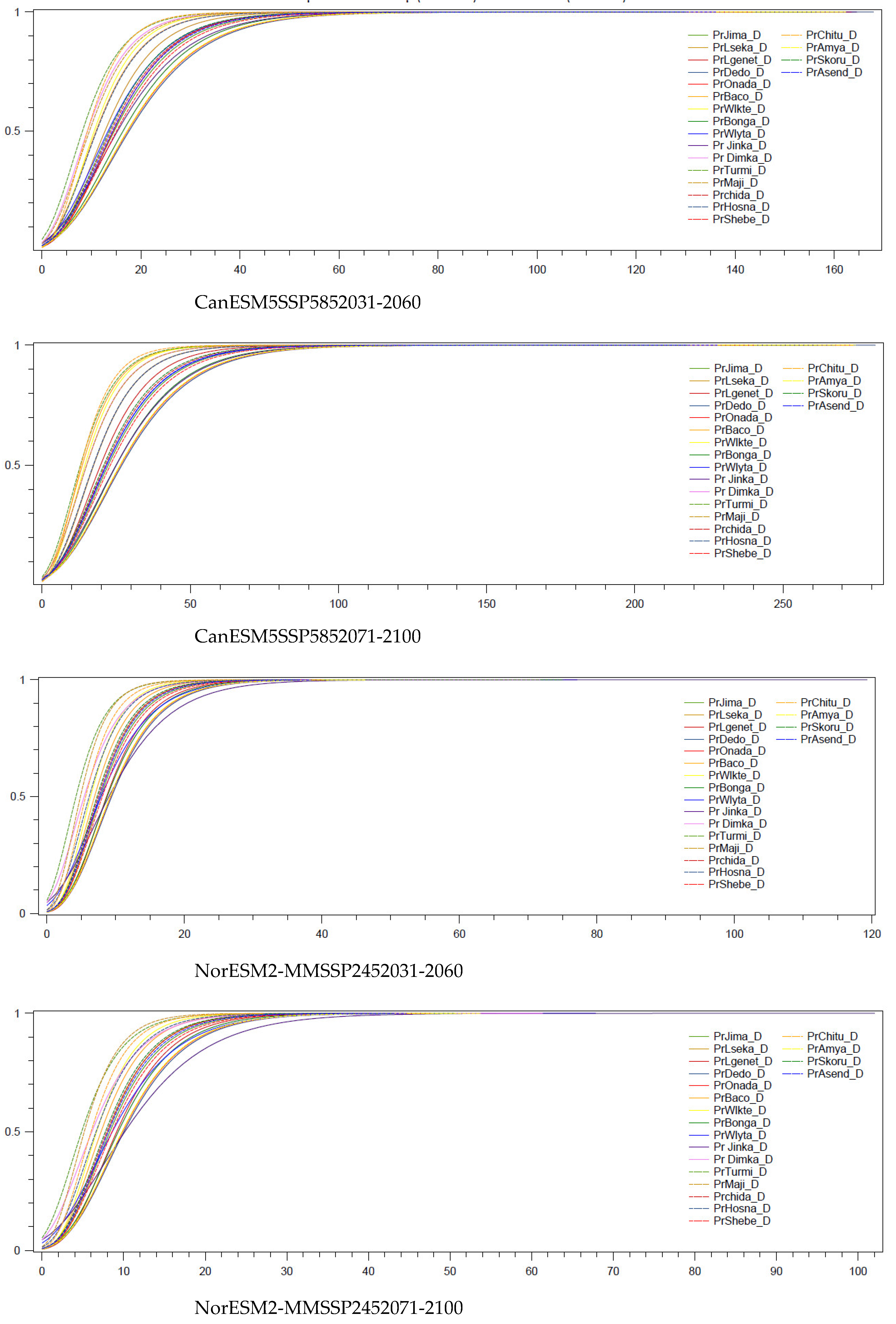
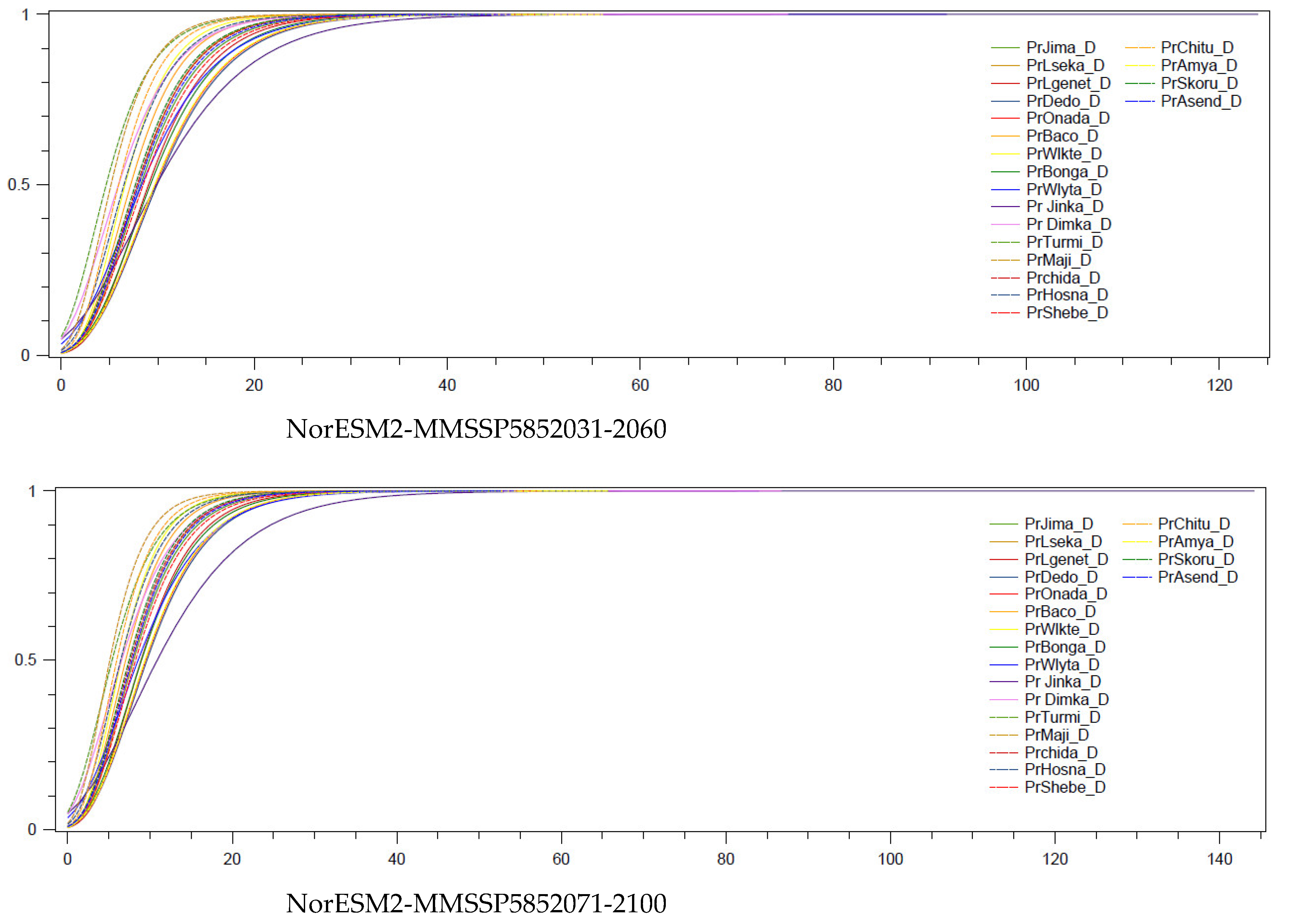
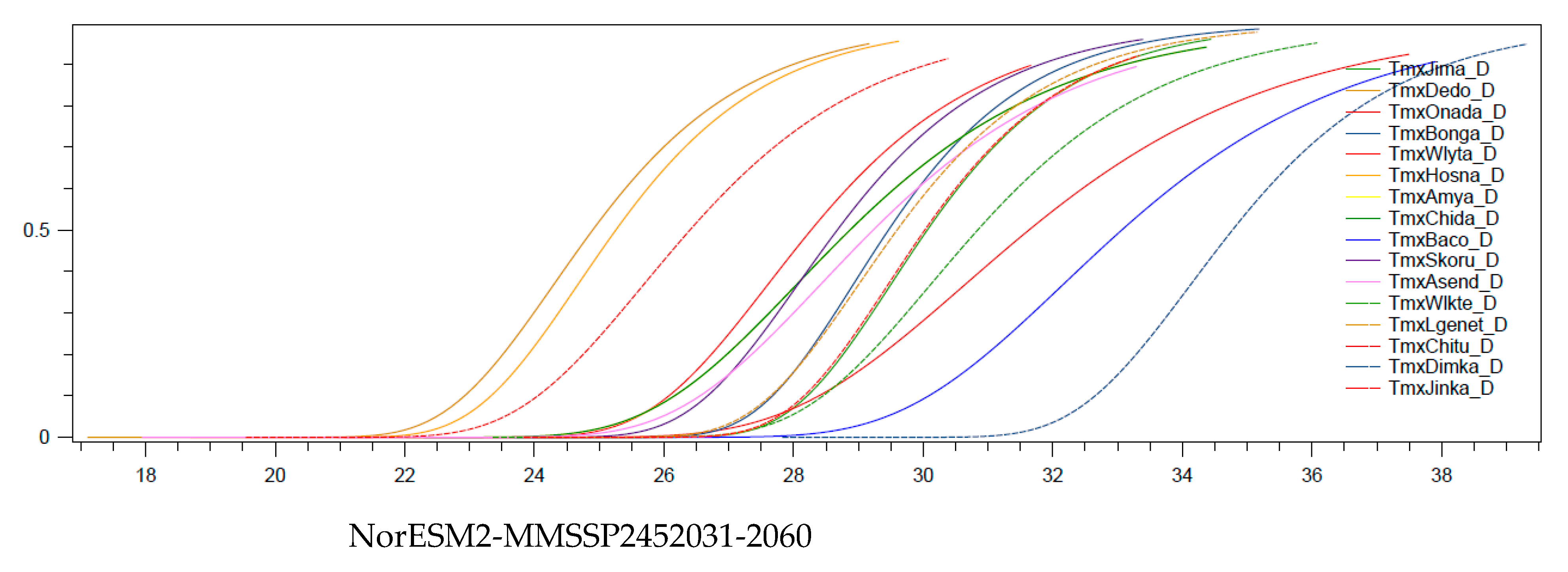
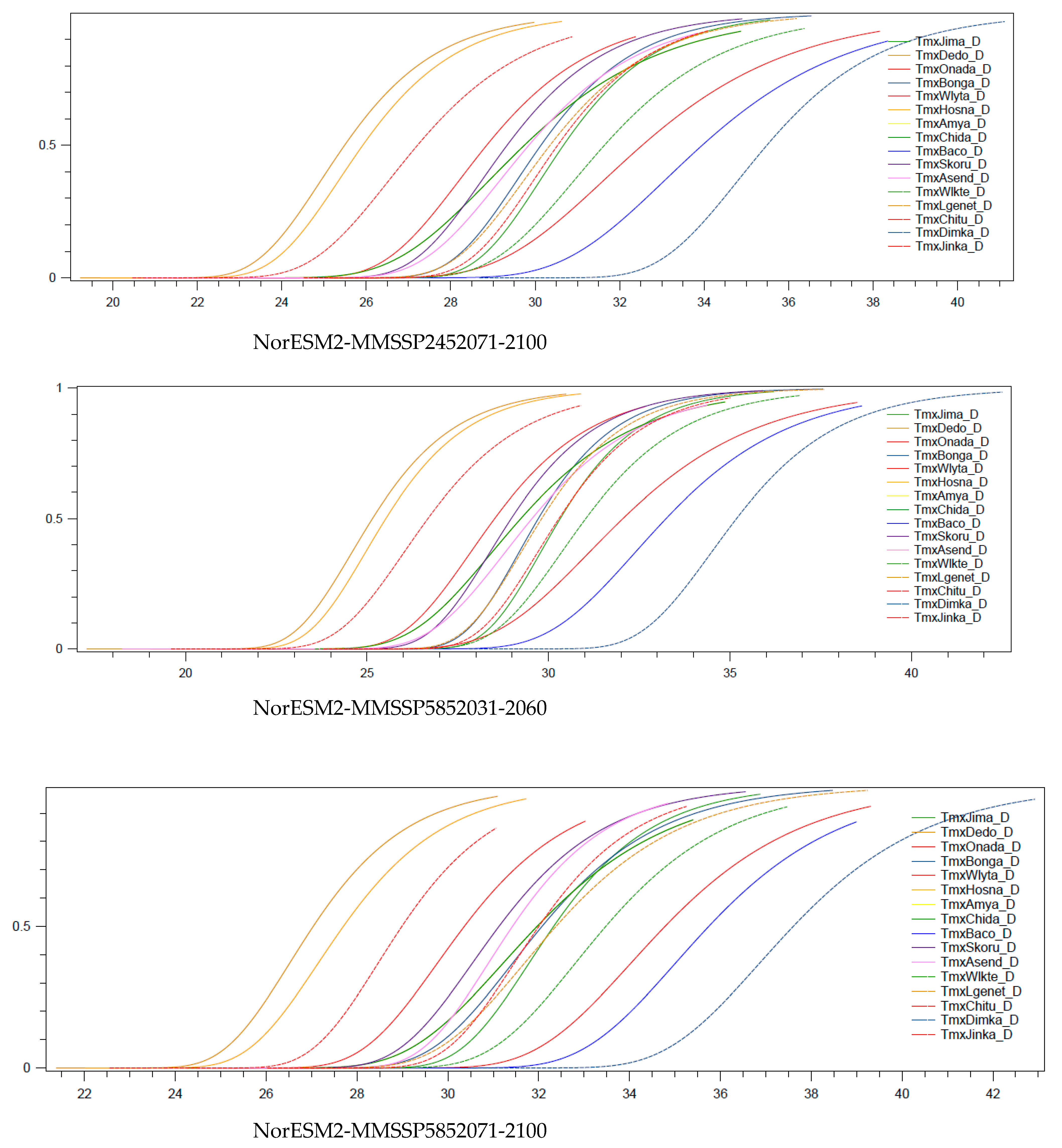
References
- Fenta Mekonnen, D.; Disse, M. Analyzing the Future Climate Change of Upper Blue Nile River Basin Using Statistical Downscaling Techniques. Hydrol. Earth Syst. Sci. 2018, 22, 2391–2408. [Google Scholar] [CrossRef] [Green Version]
- Prof Critto, A. Climate Change: Impacts, Adaptation and Vulnerability. Clim. Chang. Impacts Adapt. Vulnerability Approaches 2009, 8, 419–429. [Google Scholar]
- Ayugi, B.; Shilenje, Z.W.; Babaousmail, H.; Lim Kam Sian, K.T.C.; Mumo, R.; Dike, V.N.; Iyakaremye, V.; Chehbouni, A.; Ongoma, V. Projected Changes in Meteorological Drought over East Africa Inferred from Bias-Adjusted CMIP6 Models. Nat. Hazards 2022, 113, 1151–1176. [Google Scholar]
- Singh, R.; Biswal, B. Assessing the Impact of Climate Change on Water Resources: The Challenge Posed by a Multitude of Options; Springer: Cham, Switzerland, 2019; pp. 185–204. [Google Scholar]
- Wanders, N.; Wada, Y. Human and Climate Impacts on the 21st Century Hydrological Drought. J. Hydrol. 2015, 526, 208–220. [Google Scholar]
- Caracciolo, D.; Pumo, D.; Arnone, E.; Francipane, A.; Caracciolo, D.; Noto, L.V. Potential Implications of Climate Change and Urbanization on Watershed Hydrology; Elsevier: Amsterdam, The Netherlands, 2017. [Google Scholar]
- Ongoma, V.; Chen, H. Temporal and Spatial Variability of Temperature and Precipitation over East Africa from 1951 to 2010. Meteorol. Atmos. Phys. 2017, 129, 131–144. [Google Scholar]
- Ayugi, B.; Zhihong, J.; Zhu, H.; Ngoma, H.; Babaousmail, H.; Rizwan, K.; Dike, V. Comparison of CMIP6 and CMIP5 Models in Simulating Mean and Extreme Precipitation over East Africa. Int. J. Climatol. 2021, 41, 6474–6496. [Google Scholar] [CrossRef]
- Yengoh, G.T.; Ardö, J. Climate Change and the Future Heat Stress Challenges among Smallholder Farmers in East Africa. Atmosphere 2020, 11, 753. [Google Scholar] [CrossRef]
- Cattani, E.; Merino, A.; Guijarro, J.A.; Levizzani, V. East Africa Rainfall Trends and Variability 1983–2015 Using Three Long-Term Satellite Products. Remote Sens. 2018, 10, 931. [Google Scholar] [CrossRef] [Green Version]
- Ayugi, B.; Tan, G.; Gnitou, G.T.; Ojara, M.; Ongoma, V. Historical Evaluations and Simulations of Precipitation over East Africa from Rossby Centre Regional Climate Model. Atmos. Res. 2020, 232, 104705. [Google Scholar]
- World Food Programme. Status of Drought across the Eastern Horn; World Food Programme: Rome, Italy, 2022. [Google Scholar]
- Iyakaremye, V.; Zeng, G.; Yang, X.; Zhang, G.; Ullah, I.; Gahigi, A.; Vuguziga, F.; Asfaw, T.G.; Ayugi, B. Increased High-Temperature Extremes and Associated Population Exposure in Africa by the Mid-21st Century. Sci. Total Environ. 2021, 790, 148162. [Google Scholar] [CrossRef]
- Ahmadalipour, A.; Moradkhani, H.; Castelletti, A.; Magliocca, N. Future Drought Risk in Africa: Integrating Vulnerability, Climate Change, and Population Growth. Sci. Total Environ. 2019, 662, 672–686. [Google Scholar] [PubMed]
- Kassie, B.T.; Ittersum, V.M.; Rötter, R.; Hengsdijk, H.; Asseng, S. Climate Variability and Change in Ethiopia: Exploring Impacts and Adaptation Options for Cereal Production; Wageningen University: Wageningen, NL, USA, 2014. [Google Scholar]
- Awulachew, S.; Yilma, A.; Loulseged, M.; Loiskandl, W. Water Resources and Irrigation Development in Ethiopia; IWMI: Colombo, Sri Lanka, 2007. [Google Scholar]
- Anose, F.A.; Beketie, K.T.; Terefe Zeleke, T.; Yayeh Ayal, D.; Legese Feyisa, G. Spatio-Temporal Hydro-Climate Variability in Omo-Gibe River Basin, Ethiopia. Clim. Serv. 2021, 24, 100277. [Google Scholar]
- Chaemiso, S.E.; Abebe, A.; Pingale, S.M. Assessment of the Impact of Climate Change on Surface Hydrological Processes Using SWAT: A Case Study of Omo-Gibe River Basin, Ethiopia. Model. Earth Syst. Environ. 2016, 2, 1–15. [Google Scholar] [CrossRef] [Green Version]
- Bombelli, G.; Tomiet, S.; Bianchi, A.; Water, D.B. Impact of Prospective Climate Change Scenarios upon Hydropower Potential of Ethiopia in Gerd and Gibe Dams. Water 2021, 13, 716. [Google Scholar] [CrossRef]
- Jaweso, D.; Abate, B.; Bauwe, A.; Lennartz, B. Hydro-Meteorological Trends in the Upper Omo-Ghibe River Basin, Ethiopia. Water 2019, 11, 1951. [Google Scholar] [CrossRef] [Green Version]
- Orkodjo, T.P.; Kranjac-Berisavijevic, G.; Abagale, F.K. Impact of Climate Change on Future Precipitation Amounts, Seasonal Distribution, and Streamflow in the Omo-Gibe Basin, Ethiopia. Heliyon 2022, 8, e09711. [Google Scholar] [PubMed]
- Babaousmail, H.; Hou, R.; Ayugi, B.; Ojara, M.; Ngoma, H.; Karim, R.; Rajasekar, A.; Ongoma, V. Evaluation of the Performance of Cmip6 Models in Reproducing Rainfall Patterns over North Africa. Atmosphere 2021, 12, 475. [Google Scholar] [CrossRef]
- Baker, N.C.; Huang, H.P. A Comparative Study of Precipitation and Evaporation between CMIP3 and CMIP5 Climate Model Ensembles in Semiarid Regions. J. Clim. 2014, 27, 3731–3749. [Google Scholar] [CrossRef]
- Eyring, V.; Bony, S.; Meehl, G.A.; Senior, C.A.; Stevens, B.; Stouffer, R.J.; Taylor, K.E. Overview of the Coupled Model Intercomparison Project Phase 6 (CMIP6) Experimental Design and Organization. Geosci. Model Dev. 2016, 9, 1937–1958. [Google Scholar]
- Meehl, G.A.; Covey, C.; Delworth, T.; Latif, M.; McAvaney, B.; Mitchell, J.F.B.; Stouffer, R.J.; Taylor, K.E. The WCRP CMIP3 Multimodel Dataset: A New Era in Climatic Change Research. Bull. Am. Meteorol. Soc. 2007, 88, 1383–1394. [Google Scholar] [CrossRef] [Green Version]
- Solomon, S.; Qin, D.; Manning, M.; Averyt, K.; Marquis, M. Climate Change 2007—The Physical Science Basis: Working Group I Contribution to the Fourth Assessment Report of the IPCC; Cambridge University Press: Cambridge, UK, 2007. [Google Scholar]
- Taylor, K.E.; Stouffer, R.J.; Meehl, G.A. An Overview of CMIP5 and the Experiment Design. Bull. Am. Meteorol. Soc. 2012, 93, 485–498. [Google Scholar] [CrossRef] [Green Version]
- Sperber, K.R.; Annamalai, H.; Kang, I.S.; Kitoh, A.; Moise, A.; Turner, A.; Wang, B.; Zhou, T. The Asian Summer Monsoon: An Intercomparison of CMIP5 vs. CMIP3 Simulations of the Late 20th Century. Clim. Dyn. 2013, 41, 2711–2744. [Google Scholar] [CrossRef]
- Ogata, T.; Ueda, H.; Inoue, T.; Hayasaki, M.; Yoshida, A.; Watanabe, S.; Kira, M.; Ooshiro, M.; Kumai, A. Projected Future Changes in the Asian Monsoon: A Comparison of CMIP3 and CMIP5 Model Results. J. Meteorol. Soc. Japan 2014, 92, 207–225. [Google Scholar] [CrossRef] [Green Version]
- Zhou, T.; Zou, L.; Chen, X. Commentary on the Coupled Model Intercomparison Project Phase 6 (CMIP6). Clim. Chang. Res. 2019, 15, 445–456. [Google Scholar]
- Zhang, L.; Chen, X.; Xin, X. Short Commentary on CMIP6 Scenario Model Intercomparison Project (ScenarioMIP). Clim. Chang. Res. 2019, 15, 519–525. [Google Scholar]
- Stouffer, R.J.; Eyring, V.; Meehl, G.A.; Bony, S.; Senior, C.; Stevens, B.; Taylor, K.E. CMIP5 Scientific Gaps and Recommendations for CMIP6. Bull. Am. Meteorol. Soc. 2017, 98, 95–105. [Google Scholar] [CrossRef]
- Song, Y.H.; Chung, E.S.; Shahid, S. Spatiotemporal Differences and Uncertainties in Projections of Precipitation and Temperature in South Korea from CMIP6 and CMIP5 General Circulation Models. Int. J. Climatol. 2021, 41, 5899–5919. [Google Scholar] [CrossRef]
- Iqbal, Z.; Shahid, S.; Ahmed, K.; Ismail, T.; Khan, N.; Virk, Z.T.; Johar, W. Evaluation of Global Climate Models for Precipitation Projection in Sub-Himalaya Region of Pakistan. Atmos. Res. 2020, 245, 105061. [Google Scholar] [CrossRef]
- Salman, S.A.; Shahid, S.; Ismail, T.; Ahmed, K.; Wang, X.J. Selection of Climate Models for Projection of Spatiotemporal Changes in Temperature of Iraq with Uncertainties. Atmos. Res. 2018, 213, 509–522. [Google Scholar] [CrossRef]
- Ahmed, K.; Sachindra, D.A.; Shahid, S.; Demirel, M.C.; Chung, E.S. Selection of Multi-Model Ensemble of General Circulation Models for the Simulation of Precipitation and Maximum and Minimum Temperature Based on Spatial Assessment Metrics. Hydrol. Earth Syst. Sci. 2019, 23, 4803–4824. [Google Scholar] [CrossRef] [Green Version]
- Lin, C.Y.; Tung, C.P. Procedure for Selecting GCM Datasets for Climate Risk Assessment. Terr. Atmos. Ocean. Sci. 2017, 28, 43–55. [Google Scholar] [CrossRef] [Green Version]
- Khan, A.J.; Koch, M. Selecting and Downscaling a Set of Climate Models for Projecting Climatic Change for Impact Assessment in the Upper Indus Basin (UIB). Climate 2018, 6, 89. [Google Scholar] [CrossRef] [Green Version]
- Demirel, M.C.; Mai, J.; Mendiguren, G.; Koch, J.; Samaniego, L.; Stisen, S. Combining Satellite Data and Appropriate Objective Functions for Improved Spatial Pattern Performance of a Distributed Hydrologic Model. Hydrol. Earth Syst. Sci. 2018, 22, 1299–1315. [Google Scholar] [CrossRef] [Green Version]
- Homsi, R.; Shiru, M.S.; Shahid, S.; Ismail, T.; Harun, S.B.; Al-Ansari, N.; Chau, K.W.; Yaseen, Z.M. Precipitation Projection Using a CMIP5 GCM Ensemble Model: A Regional Investigation of Syria. Eng. Appl. Comput. Fluid Mech. 2020, 14, 90–106. [Google Scholar] [CrossRef]
- Lutz, A.F.; ter Maat, H.W.; Biemans, H.; Shrestha, A.B.; Wester, P.; Immerzeel, W.W. Selecting Representative Climate Models for Climate Change Impact Studies: An Advanced Envelope-Based Selection Approach. Int. J. Climatol. 2016, 36, 3988–4005. [Google Scholar] [CrossRef] [Green Version]
- Shiru, M.S.; Shahid, S.; Chung, E.S.; Alias, N.; Scherer, L. A MCDM-Based Framework for Selection of General Circulation Models and Projection of Spatio-Temporal Rainfall Changes: A Case Study of Nigeria. Atmos. Res. 2019, 225, 1–16. [Google Scholar] [CrossRef]
- Knutti, R.; Furrer, R.; Tebaldi, C.; Cermak, J.; Meehl, G.A. Challenges in Combining Projections from Multiple Climate Models. J. Clim. 2010, 23, 2739–2758. [Google Scholar] [CrossRef] [Green Version]
- Shiru, M.S.; Chung, E.S. Performance Evaluation of CMIP6 Global Climate Models for Selecting Models for Climate Projection over Nigeria. Theor. Appl. Climatol. 2021, 146, 599–615. [Google Scholar] [CrossRef]
- Rivera, J.A.; Arnould, G. Evaluation of the Ability of CMIP6 Models to Simulate Precipitation over Southwestern South America: Climatic Features and Long-Term Trends (1901–2014). Atmos. Res. 2020, 241, 104953. [Google Scholar] [CrossRef]
- Sreelatha, K.; Anand Raj, P. Ranking of CMIP5-Based Global Climate Models Using Standard Performance Metrics for Telangana Region in the Southern Part of India. ISH J. Hydraul. Eng. 2021, 27, 556–565. [Google Scholar] [CrossRef]
- Dibaba, W.T.; Miegel, K.; Demissie, T.A. Evaluation of the CORDEX Regional Climate Models Performance in Simulating Climate Conditions of Two Catchments in Upper Blue Nile Basin. Dyn. Atmos. Ocean. 2019, 87, 101104. [Google Scholar] [CrossRef]
- Demissie, T.A.; Sime, C.H. Assessment of the performance of CORDEX regional climate models in simulating rainfall and air temperature over southwest Ethiopia. Heliyon 2021, 7, e07791. [Google Scholar] [CrossRef]
- Ayugi, B.; Ngoma, H.; Babaousmail, H.; Karim, R.; Iyakaremye, V.; Lim Kam Sian, K.T.C.; Ongoma, V. Evaluation and Projection of Mean Surface Temperature Using CMIP6 Models over East Africa. J. African Earth Sci. 2021, 181, 104226. [Google Scholar] [CrossRef]
- Klutse, N.A.B.; Quagraine, K.A.; Nkrumah, F.; Quagraine, K.T.; Berkoh-Oforiwaa, R.; Dzrobi, J.F.; Sylla, M.B. The Climatic Analysis of Summer Monsoon Extreme Precipitation Events over West Africa in CMIP6 Simulations. Earth Syst. Environ. 2021, 5, 25–41. [Google Scholar] [CrossRef]
- Hajkowicz, S.; Collins, K. A Review of Multiple Criteria Analysis for Water Resource Planning and Management. Water Resour. Manag. 2007, 21, 1553–1566. [Google Scholar] [CrossRef]
- Hounguè, N.R.; Delos, A.; Almoradie, S.; Evers, M. A Multi Criteria Decision Analysis Approach for Regional Climate Model Selection and Future Climate Assessment in the Mono River Basin, Benin and Togo. Atmosphere 2022, 13, 1471. [Google Scholar] [CrossRef]
- Salehie, O.; Hamed, M.; Ismail, T.; Tam, T.; Shahid, S. Selection of CMIP6 GCM With Projection of Climate over The Amu Darya River Basin. Prepr. Available Res. Sq. 2021, 151, 1–27. [Google Scholar] [CrossRef]
- Srinivasa Raju, K.; Sonali, P.; Nagesh Kumar, D. Ranking of CMIP5-Based Global Climate Models for India Using Compromise Programming. Theor. Appl. Climatol. 2017, 128, 563–574. [Google Scholar] [CrossRef]
- Raju, K.S.; Kumar, D.N. Ranking of Global Climate Models for India Using Multicriterion Analysis. Clim. Res. 2014, 60, 103–117. [Google Scholar] [CrossRef]
- Meaurio, M.; Zabaleta, A.; Boithias, L.; Epelde, A.M.; Sauvage, S.; Sánchez-Pérez, J.M.; Srinivasan, R.; Antiguedad, I. Assessing the Hydrological Response from an Ensemble of CMIP5 Climate Projections in the Transition Zone of the Atlantic Region (Bay of Biscay). J. Hydrol. 2017, 548, 46–62. [Google Scholar] [CrossRef]
- Ringuest, J.L. Compromise Programming. In Multiobjective Optimization: Behavioral and Computational Considerations; Springer: Boston, MA, USA, 1992; pp. 51–59. [Google Scholar]
- Kaini, S.; Santosh Nepal, I.; Saurav Pradhananga, I.; Gardner, T.; Sharma, A.K. Representative General Circulation Models Selection and Downscaling of Climate Data for the Transboundary Koshi River Basin in China and Nepal. Wiley Online Libr. 2019, 40, 4131–4149. [Google Scholar] [CrossRef] [Green Version]
- Liu, F.; Xu, C.; Long, Y.; Yin, G.; Wang, H. Assessment of CMIP6 Model Performance for Air Temperature in the Arid Region of Northwest China and Subregions. Atmosphere 2022, 13, 454. [Google Scholar] [CrossRef]
- Mbigi, D.; Onyango, A.; Mtewele, Z.F.; Kiprotich, P.; Xiao, Z. CMIP6 Simulations of the Spatial Structure of Rainfall Variability over East Africa: Evaluation and Projection. Int. J. Climatol. 2022, 42, 9865–9885. [Google Scholar] [CrossRef]
- Gebresellase, S.H.; Wu, Z.; Xu, H.; Muhammad, W.I. Evaluation and Selection of CMIP6 Climate Models in Upper Awash Basin (UBA), Ethiopia. Theor. Appl. Climatol. 2022, 149, 1521–1547. [Google Scholar] [CrossRef]
- Alaminie, A.A.; Tilahun, S.A.; Legesse, S.A.; Zimale, F.A.; Tarkegn, G.B.; Jury, M.R.; Theodoros, M. Evaluation of Past and Future Climate Trends under CMIP6 Scenarios for the UBNB (Abay), Ethiopia. Water 2021, 13, 2110. [Google Scholar] [CrossRef]
- Degefu, M.A.; Bewket, W. Variability and Trends in Rainfall Amount and Extreme Event Indices in the Omo-Ghibe River Basin, Ethiopia. Reg. Environ. Chang. 2014, 14, 799–810. [Google Scholar] [CrossRef]
- Worku, F.F.; Werner, M.; Wright, N.; Van Der Zaag, P.; Demissie, S.S. Flow Regime Change in an Endorheic Basin in Southern Ethiopia. Hydrol. Earth Syst. Sci. 2014, 18, 3837–3853. [Google Scholar] [CrossRef] [Green Version]
- Namara, W.G.; Hirpo, G.M.; Feyissa, T.A. Evaluation of Impact of Climate Change on the Watershed Hydrology, Case of Wabe Watershed, Omo Gibe River Basin, Ethiopia. Arab. J. Geosci. 2022, 15, 1–15. [Google Scholar] [CrossRef]
- Stern, R.; Rijks, D.; Dale, I.; Knock, J. INSTAT Climatic Guide; University of Reading: Reading, UK, 2006; pp. 247–281. [Google Scholar]
- Dinku, T. Challenges with Availability and Quality of Climate Data in Africa. In Extreme Hydrology and Climate Variability; Elsevier: Amsterdam, The Netherlands, 2019; pp. 71–80. [Google Scholar]
- Dinku, T.; Faniriantsoa, R.; Islam, S.; Nsengiyumva, G.; Grossi, A. The Climate Data Tool: Enhancing Climate Services Across Africa. Front. Clim. 2022, 3, 185. [Google Scholar] [CrossRef]
- Wilby, R.; Yu, D. Rainfall and Temperature Estimation for a Data Sparse Region. Hydrol. Earth Syst. Sci. 2013, 17, 3937–3955. [Google Scholar] [CrossRef] [Green Version]
- Dinku, T.; Hailemariam, K.; Maidment, R.; Tarnavsky, E.; Connor, S. Combined Use of Satellite Estimates and Rain Gauge Observations to Generate High-Quality Historical Rainfall Time Series over Ethiopia. Int. J. Climatol. 2014, 34, 2489–2504. [Google Scholar] [CrossRef] [Green Version]
- Nikulin, G.; Jones, C.; Giorgi, F.; Asrar, G.; Büchner, M.; Cerezo-Mota, R.; Christensen, O.B.; Déqué, M.; Fernandez, J.; Hänsler, A.; et al. Precipitation Climatology in an Ensemble of CORDEX-Africa Regional Climate Simulations. J. Clim. 2012, 25, 6057–6078. [Google Scholar] [CrossRef] [Green Version]
- Sylla, M.B.; Giorgi, F.; Coppola, E.; Mariotti, L. Uncertainties in Daily Rainfall over Africa: Assessment of Gridded Observation Products and Evaluation of a Regional Climate Model Simulation. Int. J. Climatol. 2013, 33, 1805–1817. [Google Scholar] [CrossRef]
- Funk, C.; Peterson, P.; Landsfeld, M.; Davenport, F.; Becker, A.; Schneider, U.; Pedreros, D.; McNally, A.; Arsenault, K.; Harrison, L.; et al. Algorithm and Data Improvements for Version 2.1 of the Climate Hazards Center’s InfraRed Precipitation with Stations Data Set. Adv. Glob. Chang. Res. 2020, 67, 409–427. [Google Scholar]
- Harris, I.; Osborn, T.J.; Jones, P.; Lister, D. Version 4 of the CRU TS Monthly High-Resolution Gridded Multivariate Climate Dataset. Sci. Data 2020, 7, 1–18. [Google Scholar] [CrossRef] [Green Version]
- Xie, P.; Yatagai, A.; Chen, M.; Hayasaka, T.; Fukushima, Y.; Liu, C.; Yang, S. A Gauge-Based Analysis of Daily Precipitation over East Asia. J. Hydrometeorol. 2007, 8, 607–626. [Google Scholar] [CrossRef]
- Ehsani, M.; Behrangi, A. On the Importance of Gauge-Undercatch Correction Factors and Their Impacts on the Global Precipitation Estimates. Preprint 2021, 202106.0179. [Google Scholar]
- Hersbach, H.; Bell, B.; Berrisford, P.; Hirahara, S.; Horányi, A.; Muñoz-Sabater, J.; Nicolas, J.; Peubey, C.; Radu, R.; Schepers, D.; et al. The ERA5 Global Reanalysis. Q. J. R. Meteorol. Soc. 2020, 146, 1999–2049. [Google Scholar] [CrossRef]
- Aha, S.S.; Adiga, S.N.; Hiaw, C.T.; Ang, J.W.; Saha, S.; Nadiga, S.; Thiaw, C.; Wang, J.; Wang, W.; Zhang, Q.; et al. The NCEP Climate Forecast System. J. Clim. 2006, 19, 3483–3517. [Google Scholar]
- O’Neill, B.C.; Kriegler, E.; Ebi, K.L.; Kemp-Benedict, E.; Riahi, K.; Rothman, D.S.; van Ruijven, B.J.; van Vuuren, D.P.; Birkmann, J.; Kok, K.; et al. The Roads Ahead: Narratives for Shared Socioeconomic Pathways Describing World Futures in the 21st Century. Glob. Environ. Chang. 2017, 42, 169–180. [Google Scholar] [CrossRef] [Green Version]
- O’neill, B.C.; Tebaldi, C.; Van Vuuren, D.P.; Eyring, V.; Friedlingstein, P.; Hurtt, G.; Knutti, R.; Kriegler, E.; Lamarque, J.-F.; Lowe, J.; et al. The Scenario Model Intercomparison Project (ScenarioMIP) for CMIP6. Geosci. Model Dev. 2016, 9, 3461–3482. [Google Scholar] [CrossRef] [Green Version]
- Gidden, M.J.; Riahi, K.; Smith, S.J.; Fujimori, S.; Luderer, G.; Kriegler, E.; Van Vuuren, D.P.; Van Den Berg, M.; Feng, L.; Klein, D.; et al. Global Emissions Pathways under Different Socioeconomic Scenarios for Use in CMIP6: A Dataset of Harmonized Emissions Trajectories through the End of the Century. Geosci. Model Dev. 2019, 12, 1443–1475. [Google Scholar] [CrossRef] [Green Version]
- Bi, D.; Dix, M.; Marsland, S.; O’farrell, S.; Sullivan, A.; Bodman, R.; Law, R.; Harman, I.; Srbinovsky, J.; Rashid, H.A.; et al. Configuration and Spin-up of ACCESS-CM2, the New Generation Australian Community Climate and Earth System Simulator Coupled Model. J. South. Hemisph. Earth Syst. Sci. 2020, 70, 225–251. [Google Scholar] [CrossRef]
- Ziehn, T.; Chamberlain, M.A.; Law, R.M.; Lenton, A.; Bodman, R.W.; Dix, M.; Stevens, L.; Wang, Y.P.; Srbinovsky, J. The Australian Earth System Model: ACCESS-ESM1.5. J. South. Hemisph. Earth Syst. Sci. 2020, 70, 193–214. [Google Scholar] [CrossRef]
- Wu, T.; Yu, R.; Lu, Y.; Jie, W.; Fang, Y.; Zhang, J.; Zhang, L.; Xin, X.; Li, L.; Wang, Z. BCC-CSM2-HR: A High-Resolution Version of the Beijing Climate Center Climate System Model. Geosci. Model Dev. 2021, 14, 2977–3006. [Google Scholar] [CrossRef]
- Swart, N.; Scinocca, J.; Arora, V.; Christian, J.; Cole, J. The Canadian Earth System Model Version 5 Stable of Models at CCCma. Geosci. Model Dev. 2019, 12, 4823–4873. [Google Scholar] [CrossRef] [Green Version]
- Cherchi, A.; Fogli, P.G.; Lovato, T.; Peano, D.; Iovino, D.; Gualdi, S.; Masina, S.; Scoccimarro, E.; Materia, S.; Bellucci, A.; et al. Global Mean Climate and Main Patterns of Variability in the CMCC-CM2 Coupled Model. Wiley Online Libr. 2019, 11, 185–209. [Google Scholar] [CrossRef] [Green Version]
- Held, I.M.; Guo, H.; Adcroft, A.; Dunne, J.P.; Horowitz, L.W.; Krasting, J.; Shevliakova, E.; Winton, M.; Zhao, M.; Bushuk, M.; et al. Structure and Performance of GFDL’s CM4.0 Climate Model. J. Adv. Model. Earth Syst. 2019, 11, 3691–3727. [Google Scholar] [CrossRef] [Green Version]
- Dunne, J.P.; Horowitz, L.W.; Adcroft, A.J.; Ginoux, P.; Held, I.M.; John, J.G.; Krasting, J.P.; Malyshev, S.; Naik, V.; Paulot, F.; et al. The GFDL Earth System Model Version 4.1 (GFDL-ESM 4.1): Overall Coupled Model Description and Simulation Characteristics. J. Adv. Model. Earth Syst. 2020, 12, e2019MS002015. [Google Scholar] [CrossRef]
- Volodin, E.M.; Mortikov, E.V.; Kostrykin, S.V.; Galin, V.Y.; Lykossov, V.N.; Gritsun, A.S.; Diansky, N.A.; Gusev, A.V.; Iakovlev, N.G.; Shestakova, A.A.; et al. Simulation of the Modern Climate Using the INM-CM48 Climate Model. Russ. J. Numer. Anal. Math. Model. 2018, 33, 367–374. [Google Scholar] [CrossRef]
- Boucher, O.; Servonnat, J.; Albright, A.L.; Aumont, O.; Balkanski, Y.; Bastrikov, V.; Bekki, S.; Bonnet, R.; Bony, S.; Bopp, L.; et al. Presentation and Evaluation of the IPSL-CM6A-LR Climate Model. J. Adv. Model. Earth Syst. 2020, 12, e2019MS002010. [Google Scholar] [CrossRef]
- Lee, J.; Kim, J.; Sun, M.A.; Kim, B.H.; Moon, H.; Sung, H.M.; Kim, J.; Byun, Y.H. Evaluation of the Korea Meteorological Administration Advanced Community Earth-System Model (K-ACE). Asia-Pacific J. Atmos. Sci. 2020, 56, 381–395. [Google Scholar] [CrossRef] [Green Version]
- Pak, G.; Noh, Y.; Lee, M.I.; Yeh, S.W.; Kim, D.; Kim, S.Y.; Lee, J.L.; Lee, H.J.; Hyun, S.H.; Lee, K.Y.; et al. Korea Institute of Ocean Science and Technology Earth System Model and Its Simulation Characteristics. Ocean Sci. J. 2021, 56, 18–45. [Google Scholar] [CrossRef]
- Tatebe, H.; Ogura, T.; Nitta, T.; Komuro, Y.; Ogochi, K.; Takemura, T.; Sudo, K.; Sekiguchi, M.; Abe, M.; Saito, F.; et al. Description and Basic Evaluation of Simulated Mean State, Internal Variability, and Climate Sensitivity in MIROC6. Geosci. Model Dev. 2019, 12, 2727–2765. [Google Scholar] [CrossRef] [Green Version]
- Gutjahr, O.; Putrasahan, D.; Lohmann, K.; Jungclaus, J.H.; Von Storch, J.S.; Brüggemann, N.; Haak, H.; Stössel, A. Max Planck Institute Earth System Model (MPI-ESM1.2) for the High-Resolution Model Intercomparison Project (HighResMIP). Geosci. Model Dev. 2019, 12, 3241–3281. [Google Scholar]
- Mauritsen, T.; Bader, J.; Becker, T.; Behrens, J.; Bittner, M.; Brokopf, R. Developments in the MPI-M Earth System Model Version 1.2 (MPI-ESM1.2) and Its Response to Increasing CO2. Wiley Online Libr. 2019, 11, 11. [Google Scholar]
- Yukimoto, S.; Kawai, H.; Koshiro, T.; Oshima, N.; Yoshida, K.; Urakawa, S.; Tsujino, H.; Deushi, M.; Tanaka, T.; Hosaka, M.; et al. The Meteorological Research Institute Earth System Model Version 2.0, MRI-ESM2.0: Description and Basic Evaluation of the Physical Component. J. Meteorol. Soc. Japan 2019, 97, 931–965. [Google Scholar] [CrossRef] [Green Version]
- Cao, J.; Wang, B.; Yang, Y.M.; Ma, L.; Li, J.; Sun, B.; Bao, Y.; He, J.; Zhou, X.; Wu, L. The NUIST Earth System Model (NESM) Version 3: Description and Preliminary Evaluation. Geosci. Model Dev. 2018, 11, 2975–2993. [Google Scholar] [CrossRef] [Green Version]
- Seland, Ø.; Bentsen, M.; Olivié, D.; Toniazzo, T.; Gjermundsen, A.; Graff, L.S.; Debernard, B.; Gupta, A.K.; He, Y.; Kirkevåg, A.; et al. Overview of the Norwegian Earth System Model (NorESM2) and Key Climate Response of CMIP6 DECK, Historical, and Scenario Simulations. Geosci. Model Dev. 2020, 13, 6165–6200. [Google Scholar] [CrossRef]
- Wang, Y.C.; Hsu, H.H.; Chen, C.A.; Tseng, W.L.; Hsu, P.C.; Lin, C.W.; Chen, Y.L.; Jiang, L.C.; Lee, Y.C.; Liang, H.C.; et al. Performance of the Taiwan Earth System Model in Simulating Climate Variability Compared with Observations and CMIP6 Model Simulations. J. Adv. Model. Earth Syst. 2021, 13, e2020MS002353. [Google Scholar] [CrossRef]
- Yimer, S.M.; Bouanani, A.; Kumar, N.; Tischbein, B.; Borgemeister, C. Assessment of Climate Models Performance and Associated Uncertainties in Rainfall Projection from CORDEX over the Eastern Nile Basin, Ethiopia. Climate 2022, 10, 95. [Google Scholar] [CrossRef]
- Rathinasamy, M.; Khosa, R.; Adamowski, J.; Ch, S.; Partheepan, G.; Anand, J.; Narsimlu, B. Wavelet-Based Multiscale Performance Analysis: An Approach to Assess and Improve Hydrological Models. Water Resour. Res. 2014, 50, 9721–9737. [Google Scholar] [CrossRef]
- Srinivasa Raju, K.; Nagesh Kumar, D. Invited Review Paper Review of Approaches for Selection and Ensembling of GCMs. J. Water Clim. Change 2020, 11, 577–599. [Google Scholar] [CrossRef]
- Nash, J.E.; Sutcliffe, J. V River Flow Forecasting Through Conceptual Models—Part I—A Discussion of Principles. J. Hydrol. 1970, 10, 282–290. [Google Scholar] [CrossRef]
- Moriasi, D.N.; Arnold, J.G.; van Liew, M.W.; Bingner, R.L.; Harmel, R.D.; Veith, T.L. Model Evaluation Guidelines for Systematic Quantification of Accuracy in Watershed Simulations. Trans. ASABE 2007, 50, 885–900. [Google Scholar] [CrossRef]
- Chen, F.W.; Liu, C.W. Estimation of the Spatial Rainfall Distribution Using Inverse Distance Weighting (IDW) in the Middle of Taiwan. Paddy Water Environ. 2012, 10, 209–222. [Google Scholar] [CrossRef]
- Willmott, C.J. Some Comments on the Evaluation of Model Performance. Bull.-Am. Meteorol. Soc. 1982, 63, 1309–1313. [Google Scholar] [CrossRef]
- Legates, D.R.; McCabe, G.J. Evaluating the Use of ‘goodness-of-Fit’ Measures in Hydrologic and Hydroclimatic Model Validation. Water Resour. Res. 1999, 35, 233–241. [Google Scholar] [CrossRef]
- Raju, K.; Srinivasa, D.N.K. Impact of Climate Change on Water Resources. Clim. Chang. Model. Plan. Policy Agric. 2018, 219–231. [Google Scholar]
- Taylor, K.E. Summarizing Multiple Aspects of Model Performance in a Single Diagram. J. Geophys. Res. Atmos. 2001, 106, 7183–7192. [Google Scholar] [CrossRef]
- Luo, N.; Guo, Y.; Chou, J.; Gao, Z. Added Value of CMIP6 Models over CMIP5 Models in Simulating the Climatological Precipitation Extremes in China. Int. J. Climatol. 2021, 42, 1148–1164. [Google Scholar] [CrossRef]
- Mcmahon, S.; Peterson, N.A.; Winter, S.C.; Palmer, J.E.; Postmus, J.L.; Ruth, A.K. Predicting Bystander Behavior to Prevent Sexual Assault on College Campuses: The Role of Self-Efficacy and Intent. Am. J. Community Psychol. 2015, 56, 46–56. [Google Scholar] [CrossRef] [PubMed]
- Zeleny, M. Compromise Programming. In Multiple Criteria Decision Making; Springer: Berlin/Heidelberg, Germany, 1973; pp. 51–59. [Google Scholar]
- Ahmed, K.; Shahid, S.; Sachindra, D.A.; Nawaz, N.; Chung, E.S. Fidelity Assessment of General Circulation Model Simulated Precipitation and Temperature over Pakistan Using a Feature Selection Method. J. Hydrol. 2019, 573, 281–298. [Google Scholar] [CrossRef]
- Bhadran, D.; Nair, S.; Mirajkar, A.; Deepthi, B.; Sunil, A.; Nair, S.C.; Mirajkar, A.B.; Adarsh, S. Ranking of CMIP5-Based General Circulation Models Using Compromise Programming and TOPSIS for Precipitation: A Case Study of Upper Godavari Basin, India. World Sci. 2020, 2, 2050007. [Google Scholar]
- Pradhan, P.; Shrestha, S.; Sundaram, S.M.; Virdis, S.G.P. Evaluation of the CMIP5 General Circulation Models for Simulating the Precipitation and Temperature of the Koshi River Basin in Nepal. J. Water Clim. Chang. 2021, 12, 3282–3296. [Google Scholar] [CrossRef]
- Pomerol, J.-C.; Barba-Romero, S. Multicriterion Decision in Practice; Springer: Berlin/Heidelberg, Germany, 2000; pp. 299–326. [Google Scholar]
- Kiros, G.; Shetty, A.; Nandagiri, L. Analysis of Variability and Trends in Rainfall over Northern Ethiopia. Arab. J. Geosci. 2016, 9, 451. [Google Scholar] [CrossRef]
- Koudahe, K.; Kayode, A.J.; Samson, A.O.; Adebola, A.A.; Djaman, K. Trend Analysis in Standardized Precipitation Index and Standardized Anomaly Index in the Context of Climate Change in Southern Togo. Atmos. Clim. Sci. 2017, 07, 401–423. [Google Scholar] [CrossRef] [Green Version]
- Amin, A.; Nasim, W.; Mubeen, M.; Kazmi, H.; Lin, Z.; Wahid, A.; Refat Sultana, S.; Gibbs, J.; Fahad, S. Comparison of Future and Base Precipitation Anomalies by SimCLIM Statistical Projection through Ensemble Approach in Pakistan; Elsevier: Amsterdam, The Netherlands, 2017; Volume 194, pp. 214–225. [Google Scholar]
- Ongoma, V.; Chen, H.; Omony, G.W. Variability of Extreme Weather Events over the Equatorial East Africa, a Case Study of Rainfall in Kenya and Uganda. Theor. Appl. Climatol. 2018, 131, 295–308. [Google Scholar] [CrossRef]
- Salami, A.W.; Olanlokun, O.; Salami, A.W.; Mohammed, A.A.; Abdulmalik, Z.H.; Olanlokun, O.K. Trend Analysis of Hydro-Meteorological Variables Using the Mann-Kendall Trend Test: Application to the Niger River and the Benue Sub-Basins in Nigeria. Int. J. Technol. 2014, 2, 100–110. [Google Scholar] [CrossRef] [Green Version]
- Tabari, H.; Somee, B.S.; Zadeh, M.R. Testing for Long-Term Trends in Climatic Variables in Iran. Atmos. Res. 2011, 100, 132–140. [Google Scholar] [CrossRef]
- Sime, C.H.; Demissie, T.A. Assessment and Prediction of the Climate Change Impact on Crop Yield, in Jimma Zone Upper Gilgel Gibe Districts, Ethiopia. Arab. J. Geosci. 2022, 15, 1–15. [Google Scholar] [CrossRef]
- Tebaldi, C.; Smith, R.L.; Nychka, D.; Mearns, L.O. Quantifying Uncertainty in Projections of Regional Climate Change: A Bayesian Approach to the Analysis of Multimodel Ensembles. J. Clim. 2005, 18, 1524–1540. [Google Scholar] [CrossRef] [Green Version]
- Hamed, M.M.; Nashwan, M.S.; Shahid, S. Inter-Comparison of Historical Simulation and Future Projections of Rainfall and Temperature by CMIP5 and CMIP6 GCMs over Egypt. Int. J. Climatol. 2022, 42, 4316–4332. [Google Scholar] [CrossRef]
- Salman, S.A.; Nashwan, M.S.; Ismail, T.; Shahid, S. Selection of CMIP5 General Circulation Model Outputs of Precipitation for Peninsular Malaysia. Hydrol. Res. 2020, 51, 781–798. [Google Scholar] [CrossRef]
- Orkodjo, T.P.; Kranjac-Berisavijevic, G.; Abagale, F.K. Abagale. Impact of climate change on future availability of water for irrigation and hydropower generation in the Omo-Gibe Basin of Ethiopia. J. Hydrol. Reg. Stud. 2022, 44, 101254. [Google Scholar] [CrossRef]
- Krakauer, N.Y.; Abebe Balcha, Y.; Malcherek, A.; Alamirew, T. Understanding Future Climate in the Upper Awash Basin (UASB) with Selected Climate Model Outputs under CMIP6. Climate 2022, 10, 185. [Google Scholar]
- Zhu, H.; Jiang, Z.; Li, L. Projection of Climate Extremes in China, an Incremental Exercise from CMIP5 to CMIP6. Sci. Bull. 2021, 66, 2528–2537. [Google Scholar] [CrossRef] [PubMed]
- Tewari, K.; Mishra, S.; Salunke, P.; Dewan, A. Future Projections of Temperature and Precipitation for Antarctica. Environ. Res. Lett. 2022, 17, 014029. [Google Scholar] [CrossRef]
- Tong, M.; Zheng, Z.; Fu, Q. Evaluation of East Asian Meiyu from CMIP6/AMIP Simulations. Clim. Dyn. 2022, 59, 2429–2444. [Google Scholar] [CrossRef]
- Nath Raila, S.; Acharya, R.; Ghimire, S.; Adhikari, S.; Khanal, S.; Mishra, Y.; Lamichhane, M. Out-Performing Bias-Corrected GCM Models and CMIP6-Based Precipitation and Temperature Projections for the Bagmati Irrigation Area. Nepjol. Info 2022, 7, 2022. [Google Scholar]
- Cui, T.; Li, C.; Science, F.T.-E. Evaluation of Temperature and Precipitation Simulations in CMIP6 Models over the Tibetan Plateau. Earth Space Sci. 2021, 8, e2020EA001620. [Google Scholar] [CrossRef]
- Song, S.; Zhang, X.; Yan, X. Evaluation of the Performance of CMIP6 Model Simulations for the Asian-Pacific Region: Perspectives from Multiple Dimensions. Res. Sq. 2022. [Google Scholar] [CrossRef]
- Lamichhane, M.; Mishra, Y.; Change, P.B.-J.E.S.C. Assessment of Future Water Availability and Irrigation Water Demand under Climate Change in the Kankai River Basin, Nepal. J. Earth Sci. Clim. Change 2022, 13, 2. [Google Scholar]
- Wagesho, N.; Goel, N.; Journal, M.J.-H.S. Temporal and Spatial Variability of Annual and Seasonal Rainfall over Ethiopia. Taylor Fr. 2013, 58, 354–373. [Google Scholar] [CrossRef]
- Zeleke, T.; Giorgi, F.; Mengistu Tsidu, G.; Diro, G.T. Spatial and Temporal Variability of Summer Rainfall over Ethiopia from Observations and a Regional Climate Model Experiment. Theor. Appl. Climatol. 2013, 111, 665–681. [Google Scholar] [CrossRef]
- Teshome Ayana, M.; Wagesho, N.; Abdella Kemal Mohammed, I.; Kemal Mohammed, A. Assessment of the Impacts of Climate Change on Gibe-III Reservoir Using Reliability, Resilience and Vulnerability (RRV) Indices. Int. J. Sci. Eng. Res. 2017, 8, 1606–1628. [Google Scholar]
- Demissie, T.A.; Saathoff, F.; Seleshi, Y.; Gebissa, A. Trends Of Hydro-Meteorological Data And Impact Of Climate Change On The Streamflow Of Gilgel Gibe 1 River Basin-Ethiopia. Int. J. Curr. Res. 2013, 5, 2988–2993. [Google Scholar]
- Saathoff, F.W.; Barbaro, G.; Aldieri, L.; Tenfie, H.W.; Saathoff, F.; Hailu, D.; Gebissa, A. Selection of Representative General Circulation Models for Climate Change Study Using Advanced Envelope-Based and Past Performance Approach on Transboundary River Basin, a Case of Upper Blue Nile Basin, Ethiopia. Sustainability 2022, 14, 2140. [Google Scholar]
- Choi, Y.W.; Campbell, D.J.; Eltahir, E.A.B. Near-Term Regional Climate Change in East Africa. Clim. Dyn. 2022, 12, 1–18. [Google Scholar] [CrossRef]
- Camberlin, P. Climate of Eastern Africa; Oxford Research Encyclopedia of Climate Science: Oxford, UK, 2018. [Google Scholar]
- Preethi, B.; Sabin, T.P.; Adedoyin, J.A.; Ashok, K. Impacts of the ENSO Modoki and Other Tropical Indo-Pacific Climate-Drivers on African Rainfall OPEN. Nat. Publ. Gr. 2015, 5, 16653. [Google Scholar]
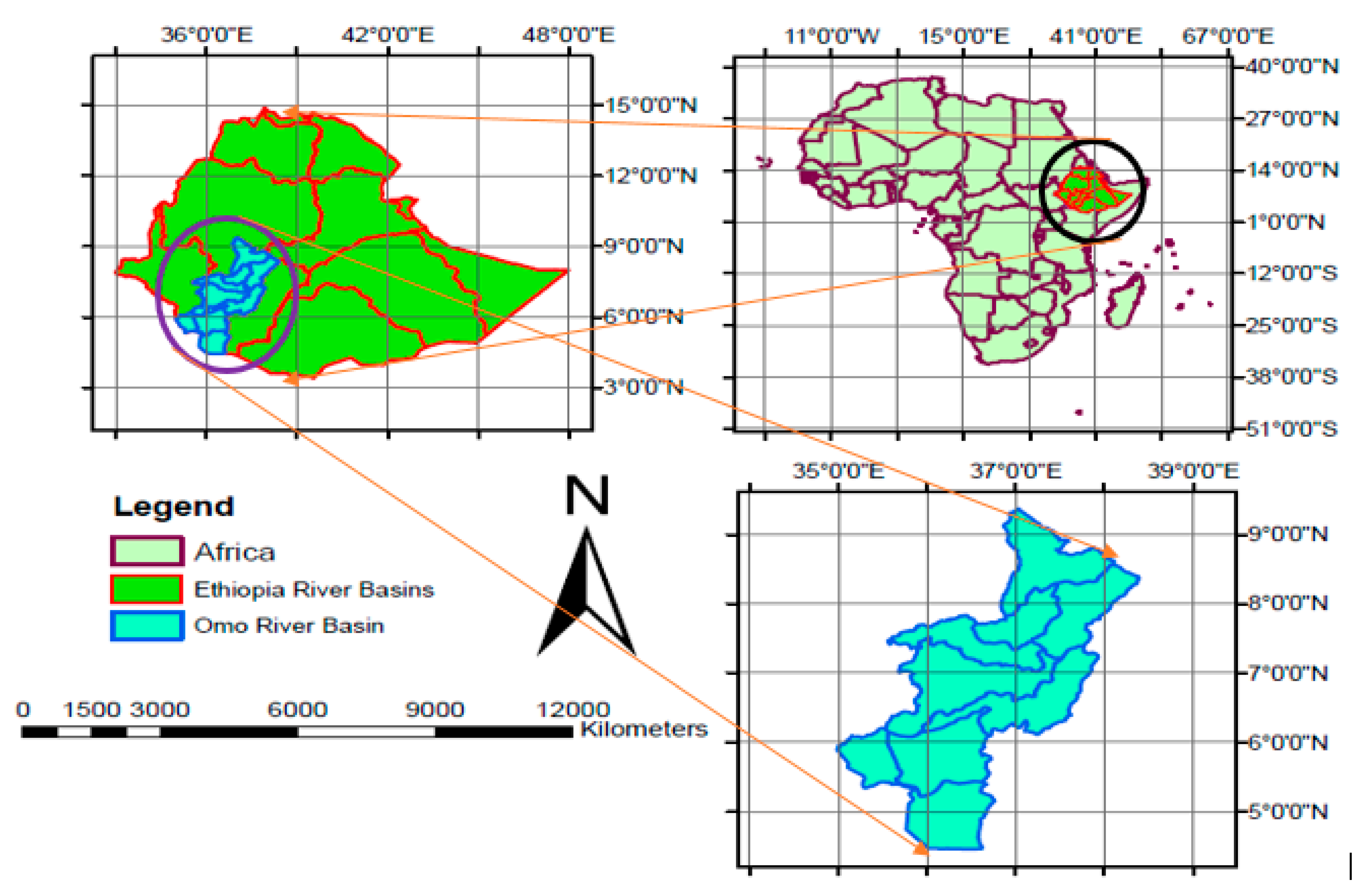
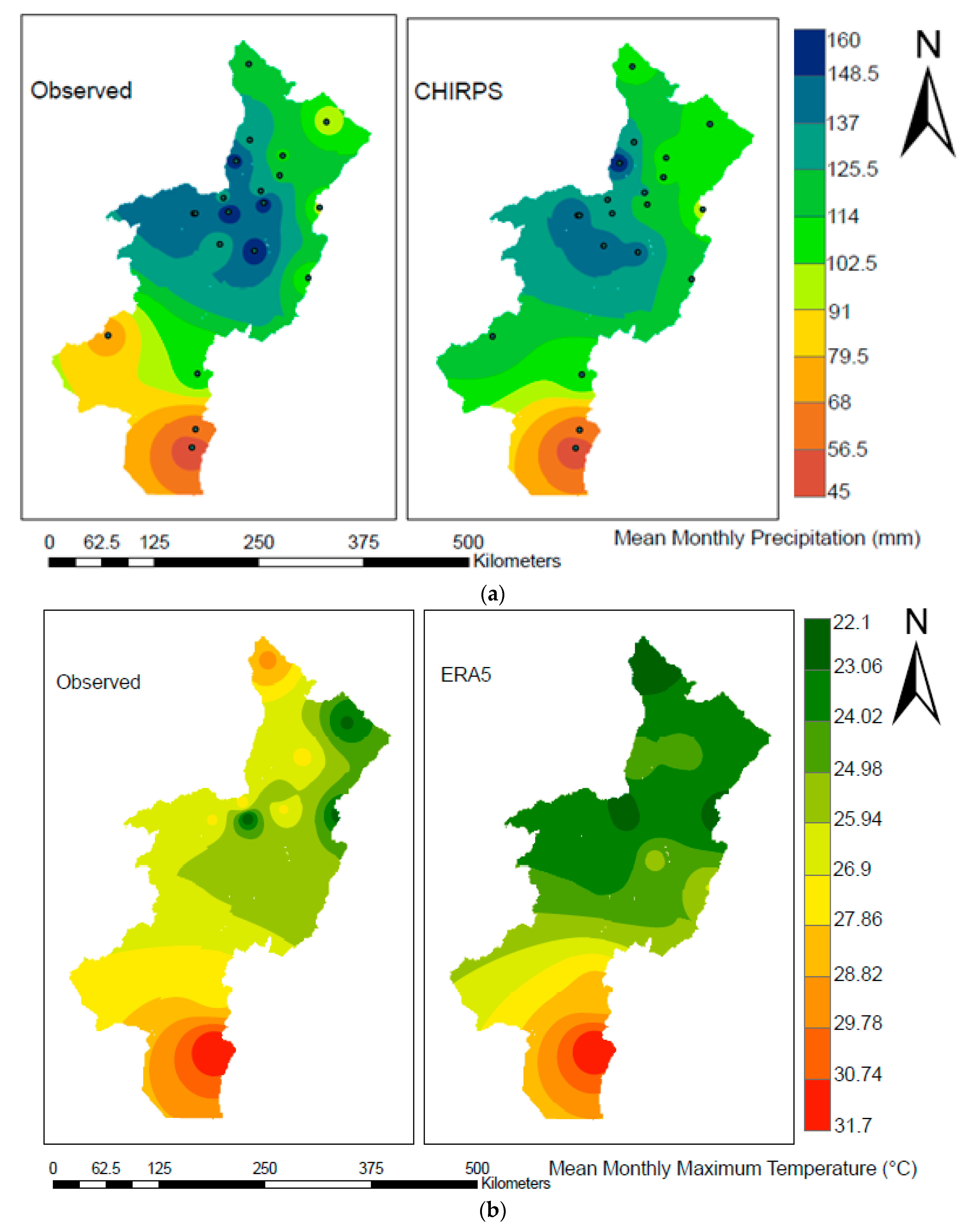

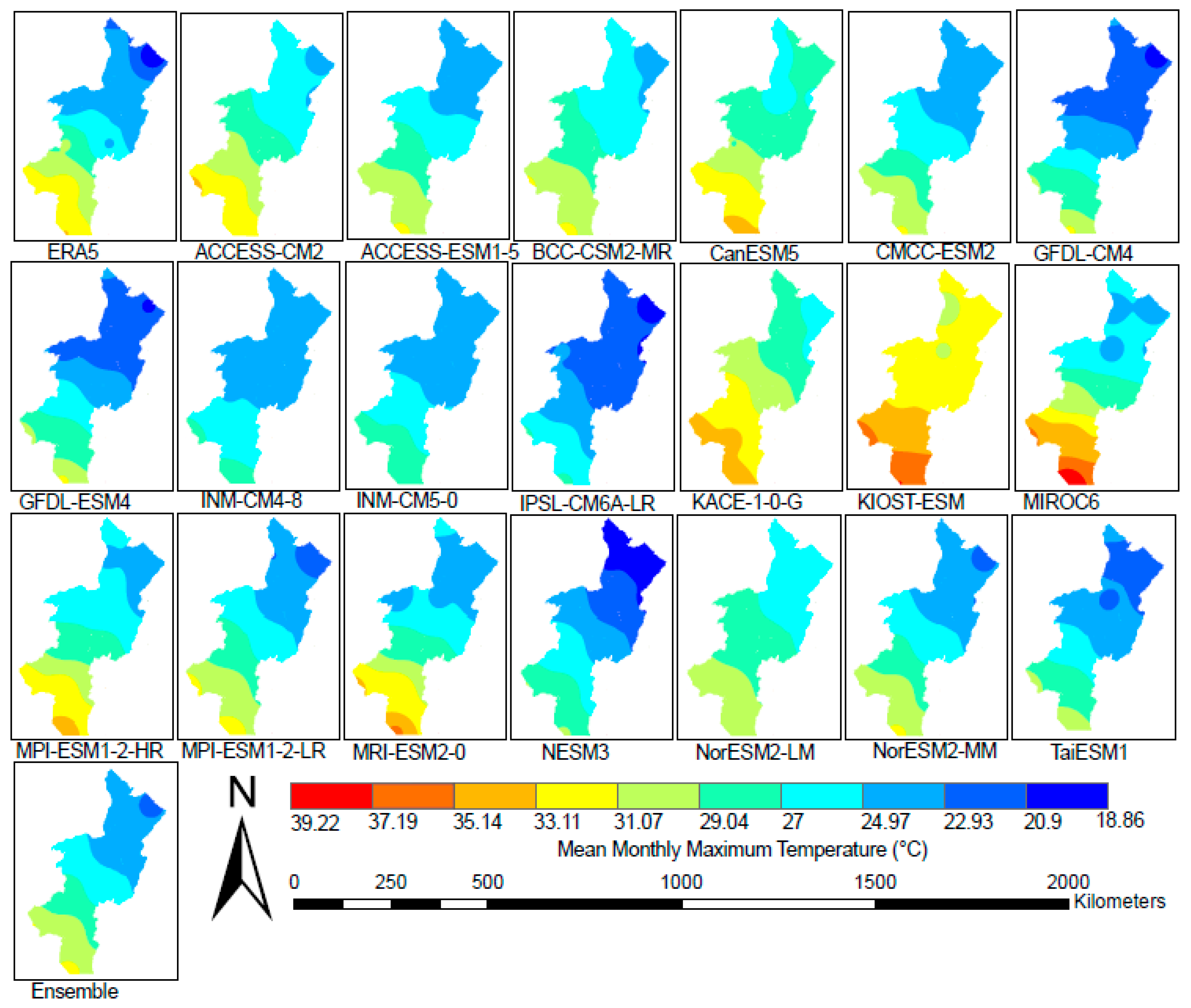
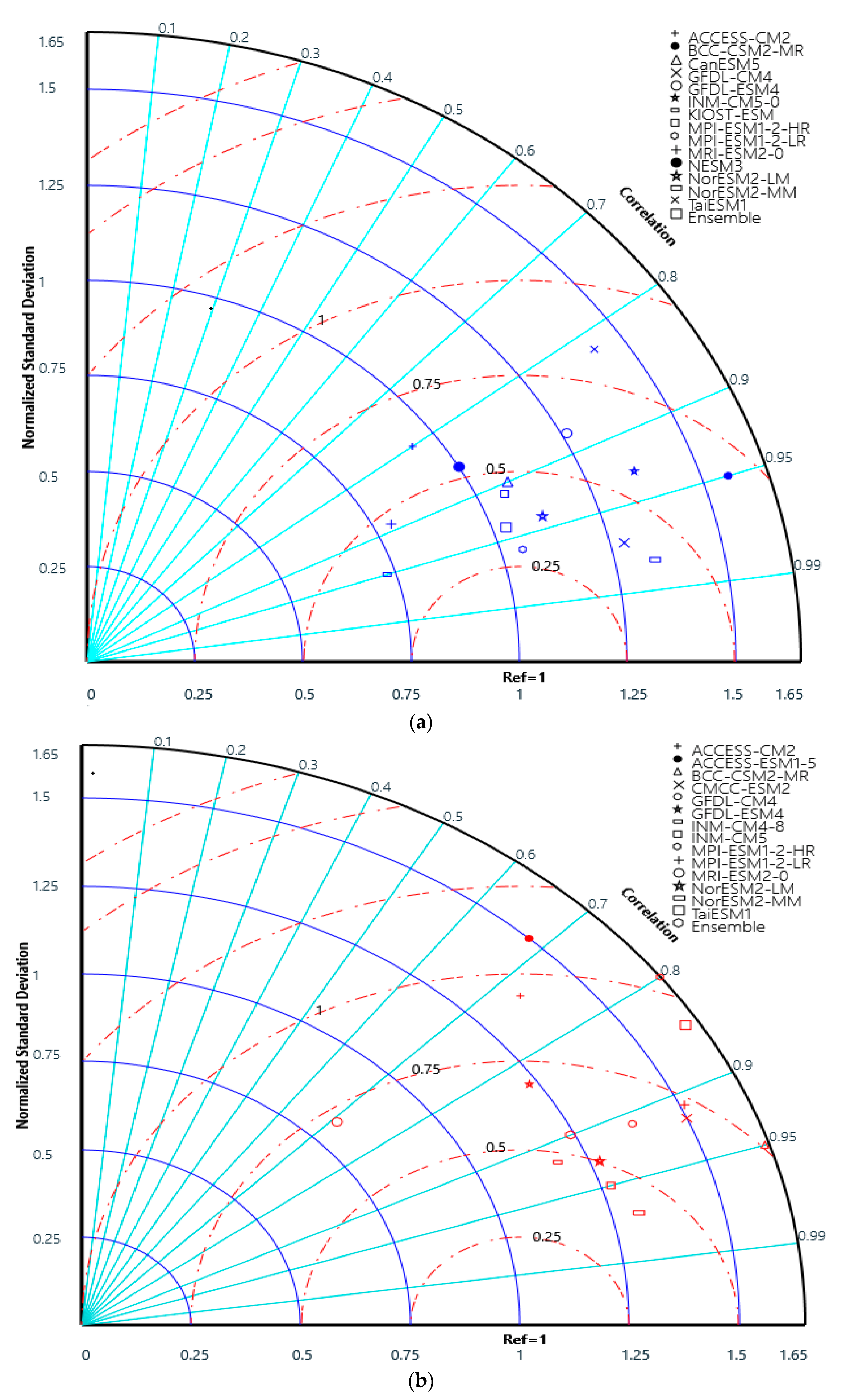
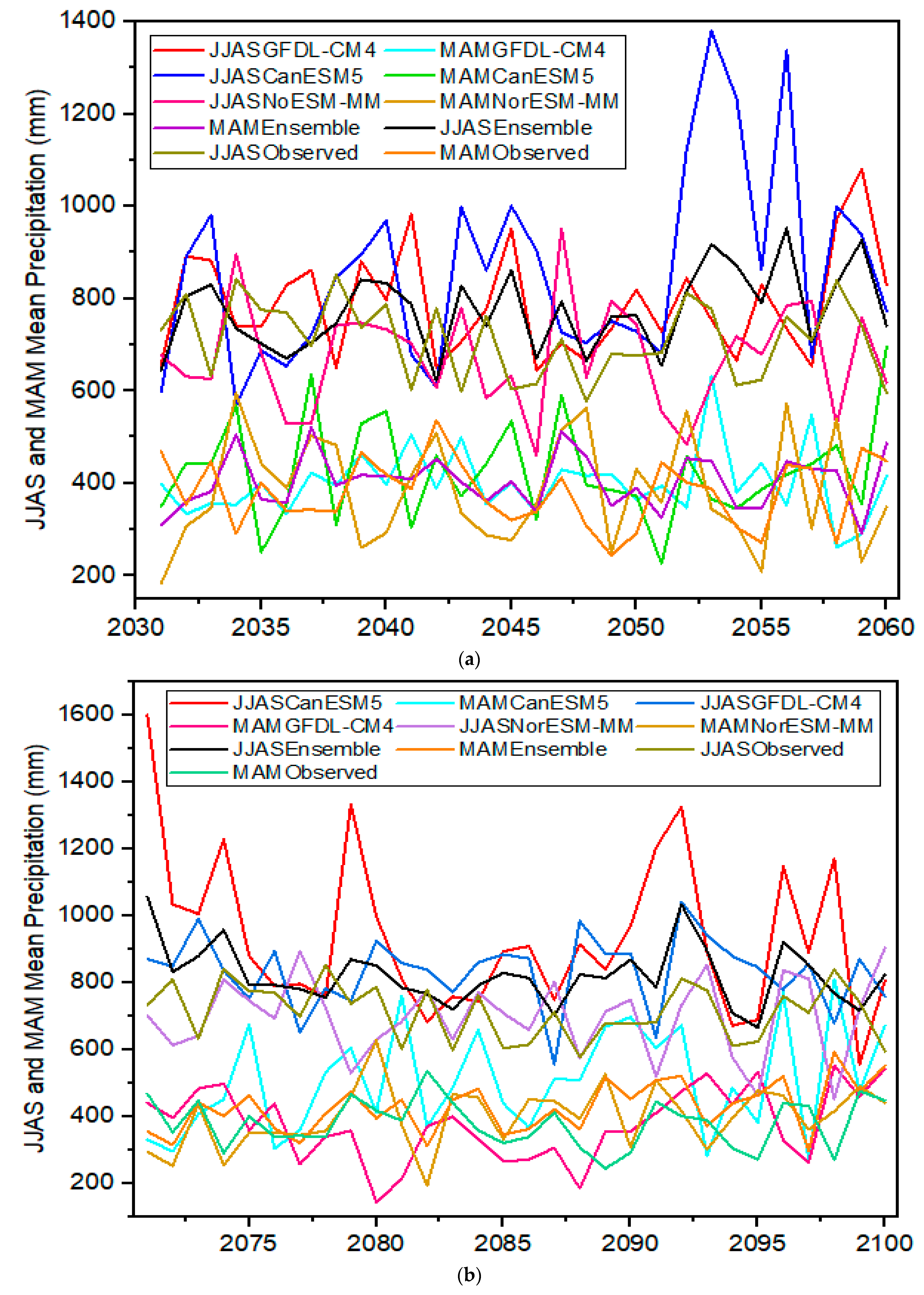





| S.No. | GCMs CMIP6 Name | Country | Horizontal Res (lon. lat. deg) | Key References |
|---|---|---|---|---|
| 1 | ACCESS-CM2 | Australia | 1.87° × 1.25° | [82] |
| 2 | ACCESS-ESM1-5 | Australia | 1.9° × 1.2° | [83] |
| 3 | BCC-CSM2-MR | China | 1.1° × 1.1° | [84] |
| 4 | CanESM5 | Canada | 2.8° × 2.8° | [85] |
| 5 | CMCC-ESM2 | Italy | 0.94° × 1.25° | [86] |
| 6 | GFDL-CM4 | USA | 2.50° × 2.00° | [87] |
| 7 | GFDL-ESM4 | USA | 1.00° × 1.25° | [88] |
| 8 | INM-CM4-8 | Russia | 2° × 1.5° | [89] |
| 9 | IPSL-CM6A-LR | France | 2.50° × 1.27° | [90] |
| 10 | INM-CM5-0 | Russia | 2.00° × 1.50° | [89] |
| 11 | KACE-1-0-G | South Korea | 1.9° × 1.3° | [91] |
| 12 | KIOST-ESM | Korea | 2.2° × 2.2° | [92] |
| 13 | MIROC6 | Japan | 1.4° × 1.4° | [93] |
| 14 | MPI-ESM1-2-HR | Germany | 0.94° × 0.94° | [94] |
| 15 | MPI-ESM1-2-LR | Germany | 1.87° × 1.86° | [95] |
| 16 | MRI-ESM2-0 | Japan | 1.1° × 1.1° | [96] |
| 17 | NESM3 | China | 1.9° × 1.9° | [97] |
| 18 | NorESM2-LM | Norway | 2.5° × 1.9° | [98] |
| 19 | NorESM2-MM | Norway | 0.9° × 1.3° | [98] |
| 20 | TaiESM1 | Taiwan | 0.9° × 0.9° | [99] |
| Mean Monthly Gridded Data | CHIRPS | CGCC | CPC | ERA5 | CRU |
|---|---|---|---|---|---|
| Precipitation (mm) | |||||
| NSE | 0.78 | 0.04 | 0.12 | 0.29 | −1.84 |
| D | 0.94 | 0.68 | 0.77 | 0.83 | 0.34 |
| RMSE | 28.29 | 59.35 | 56.81 | 48.45 | 102.34 |
| Pearson coefficient (CC) | 0.98 | 0.43 | 0.98 | 0.73 | −0.18 |
| Temperature (°C) | |||||
| NSE | 0.13 | 0.81 | −0.01 | ||
| D | 0.81 | 0.95 | 0.77 | ||
| RMSE | 1.61 | 0.75 | 1.72 | ||
| Pearson coefficient (CC) | 0.97 | 0.94 | 0.83 |
| GCMs | NSE | Pbias | SS | NRMSE | CC | Lp Value | Rank | |
|---|---|---|---|---|---|---|---|---|
| 1 | ACCESS-CM2 | 0.36 | 0.07 | 0.05 | 0.03 | 0.02 | 0.54 | 18 |
| 2 | ACCESS-ESM1-5 | 1.09 | 0.12 | 0.03 | 0.03 | 0.04 | 1.31 | 21 |
| 3 | BCC-CSM2-MR | 0.41 | 0.07 | 0.03 | 0.01 | 0.00 | 0.53 | 17 |
| 4 | CanESM5 | 0.08 | 0.03 | 0.03 | 0.01 | 0.01 | 0.15 | 5 |
| 5 | CMCC-ESM2 | 0.41 | 0.06 | 0.04 | 0.03 | 0.06 | 0.60 | 20 |
| 6 | GFDL-CM4 | 0.06 | 0.02 | 0.04 | 0.00 | 0.00 | 0.13 | 3 |
| 7 | GFDL-ESM4 | 0.15 | 0.02 | 0.03 | 0.01 | 0.01 | 0.21 | 7 |
| 8 | INM-CM4-8 | 0.38 | 0.12 | 0.03 | 0.02 | 0.01 | 0.57 | 19 |
| 9 | IPSL-CM6A-LR | 0.28 | 0.06 | 0.03 | 0.02 | 0.02 | 0.41 | 11 |
| 10 | INM-CM5-0 | 0.39 | 0.07 | 0.01 | 0.01 | 0.01 | 0.49 | 16 |
| 11 | KACE-1-0-G | 0.19 | 0.00 | 0.10 | 0.09 | 0.09 | 0.46 | 14 |
| 12 | KIOST-ESM | 0.20 | 0.06 | 0.05 | 0.03 | 0.09 | 0.44 | 13 |
| 13 | MIROC6 | 1.61 | 0.20 | 0.03 | 0.03 | 0.00 | 1.87 | 22 |
| 14 | MPI-ESM1-2-HR | 0.19 | 0.05 | 0.05 | 0.02 | 0.01 | 0.32 | 10 |
| 15 | MPI-ESM1-2-LR | 0.15 | 0.06 | 0.03 | 0.02 | 0.00 | 0.26 | 9 |
| 16 | MRI-ESM2-0 | 0.16 | 0.05 | 0.00 | 0.01 | 0.01 | 0.22 | 8 |
| 17 | NESM3 | 0.28 | 0.06 | 0.04 | 0.03 | 0.01 | 0.43 | 12 |
| 18 | NorESM2-LM | 0.07 | 0.03 | 0.05 | 0.01 | 0.00 | 0.16 | 6 |
| 19 | NorESM2-MM | 0.07 | 0.02 | 0.04 | 0.00 | 0.00 | 0.14 | 4 |
| 20 | TaiESM1 | 0.36 | 0.04 | 0.04 | 0.01 | 0.02 | 0.47 | 15 |
| All Ensemble | 0.05 | 0.02 | 0.03 | 0.00 | 0.00 | 0.10 | 2 | |
| Top3Ensemble | 0.00 | 0.00 | 0.04 | 0.00 | 0.00 | 0.05 | 1 |
| GCMs | NSE | Pbias | SS | NRMSE | Person | Lp Value | Rank | |
|---|---|---|---|---|---|---|---|---|
| 1 | ACCESS-CM2 | 1.08 | 0.01 | 0.04 | 0.00 | 0.03 | 1.16 | 16 |
| 2 | ACCESS-ESM1-5 | 0.56 | 0.00 | 0.03 | 0.00 | 0.04 | 0.63 | 9 |
| 3 | BCC-CSM2-MR | 0.46 | 0.00 | 0.03 | 0.00 | 0.00 | 0.49 | 8 |
| 4 | CanESM5 | 2.43 | 0.01 | 0.04 | 0.00 | 0.02 | 2.51 | 19 |
| 5 | CMCC-ESM2 | 0.16 | 0.00 | 0.04 | 0.00 | 0.01 | 0.21 | 5 |
| 6 | GFDL-CM4 | 1.05 | 0.01 | 0.05 | 0.00 | 0.01 | 1.12 | 15 |
| 7 | GFDL-ESM4 | 0.86 | 0.01 | 0.05 | 0.00 | 0.02 | 0.94 | 13 |
| 8 | INM-CM4-8 | 0.59 | 0.01 | 0.05 | 0.00 | 0.01 | 0.66 | 10 |
| 9 | INM-CM5 | 0.32 | 0.01 | 0.04 | 0.00 | 0.00 | 0.37 | 6 |
| 10 | IPSL-CM6A-LR | 3.20 | 0.02 | 0.08 | 0.00 | 0.03 | 3.33 | 20 |
| 11 | KACE-1-0-G | 4.92 | 0.02 | 0.09 | 0.00 | 0.08 | 5.12 | 21 |
| 12 | KIOST-ESM | 16.01 | 0.04 | 0.07 | 0.01 | 0.01 | 16.12 | 22 |
| 13 | MIROC6 | 2.43 | 0.02 | 0.05 | 0.00 | 0.00 | 2.50 | 18 |
| 14 | MPI-ESM1-2-HR | 0.95 | 0.01 | 0.04 | 0.00 | 0.02 | 1.02 | 14 |
| 15 | MPI-ESM1-2-LR | 0.16 | 0.00 | 0.01 | 0.00 | 0.01 | 0.18 | 3 |
| 16 | MRI-ESM2-0 | 0.62 | 0.01 | 0.04 | 0.00 | 0.03 | 0.70 | 11 |
| 17 | NESM3 | 1.96 | 0.01 | 0.08 | 0.00 | 0.03 | 2.08 | 17 |
| 18 | NorESM2-LM | 0.46 | 0.01 | 0.01 | 0.00 | 0.00 | 0.48 | 7 |
| 19 | NorESM2-MM | 0.00 | 0.00 | 0.02 | 0.00 | 0.00 | 0.02 | 1 |
| 20 | TaiESM1 | 0.78 | 0.01 | 0.05 | 0.00 | 0.01 | 0.85 | 12 |
| All Ensemble | 0.17 | 0.00 | 0.03 | 0.00 | 0.01 | 0.20 | 4 | |
| Top3Ensemble | 0.06 | 0.00 | 0.00 | 0.00 | 0.00 | 0.06 | 2 |
| GFDL-CM4-Precipiatation (mm) | Z | p | CanESM5-Precipiatation (mm) | Z | p |
|---|---|---|---|---|---|
| SSP2452031_2060-JJAS | 0.07 | 0.94 | SSP2452031_2060JJAS | 2.14 | 0.03 |
| SSP2452031_2060-MAM | 0.18 | 0.86 | SSP2452031_2060MAM | 0.11 | 0.91 |
| SSP2452071_2100-JJAS | −0.07 | 0.94 | SSP2452071_2100JJAS | −1.21 | 0.23 |
| SSP2452071_2100-MAM | 1.00 | 0.32 | SSP2452071_2100MAM | 1.86 | 0.06 |
| SSP5852031_2060-JJAS | 1.71 | 0.09 | SSP5852031_2060JJAS | 2.18 | 0.03 |
| SSP5852031_2060-MAM | 1.78 | 0.07 | SSP5852031_2060MAM | 0.86 | 0.39 |
| SSP5852071_2100-JJAS | 1.39 | 0.16 | SSP5852071_2100JJAS | 1.11 | 0.27 |
| SSP5852071_2100-MAM | 1.14 | 0.25 | SSP5852071_2100MAM | 1.61 | 0.11 |
| NorESM2-MM-Precipiatation (mm) | Ensemble | ||||
| SSP2452031_2060JJAS | 0.11 | 0.91 | SSP2452031_2060JJAS | 0.77 | 0.63 |
| SSP2452031_2060MAM | −0.04 | 0.97 | SSP2452031_2060MAM | 0.08 | 0.91 |
| SSP2452071_2100JJAS | 0.36 | 0.72 | SSP2452071_2100JJAS | −0.31 | 0.63 |
| SSP2452071_2100MAM | 2.14 | 0.03 | SSP2452071_2100MAM | 1.67 | 0.14 |
| SSP5852031_2060JJAS | −0.82 | 0.41 | SSP5852031_2060JJAS | 1.02 | 0.18 |
| SSP5852031_2060MAM | 0.11 | 0.91 | SSP5852031_2060MAM | 0.92 | 0.46 |
| SSP5852071_2100JJAS | −0.46 | 0.64 | SSP5852071_2100JJAS | 0.68 | 0.36 |
| SSP5852071_2100MAM | 0.79 | 0.43 | SSP5852071_2100MAM | 1.18 | 0.26 |
| NorESM2-MM-Temperature (°C) | Z | p | MPI-ESM1-2-LR-Temperature (°C) | Z | p |
|---|---|---|---|---|---|
| SSP2452031_2060JJAS | 3.07 | 0.00 | SSP2452031_2060JJAS | 0.86 | 0.39 |
| SSP2452031_2060MAM | 1.82 | 0.07 | SSP2452031_2060MAMM | 0.71 | 0.48 |
| SSP2452071_2100JJAS | 0.89 | 0.37 | SSP2452071_2100JJAS | 1.00 | 0.32 |
| SSP2452071_2100MAM | −0.79 | 0.43 | SSP2452071_2100MAM | 0.79 | 0.43 |
| SSP5852031_2060JJAS | 2.71 | 0.01 | SSP5852031_2060JJAS | 1.86 | 0.06 |
| SSP5852031_2060MAM | 1.39 | 0.16 | SSP5852031_2060MAM | 1.32 | 0.19 |
| SSP5852071_2100JJAS | 3.85 | 0.00 | SSP5852071_2100JJAS | 2.71 | 0.01 |
| SSP5852071_2100MAM | 2.43 | 0.02 | SSP5852071_2100MAM | 1.43 | 0.15 |
| CMCC-ESM2-Temperature (°C) | Ensemble | ||||
| SSP2452031_2060JJAS | 2.32 | 0.02 | SSP2452031_2060JJAS | 2.08 | 0.14 |
| SSP2452031_2060MAM | 2.21 | 0.03 | SSP2452031_2060MAM | 1.58 | 0.19 |
| SSP2452071_2100JJAS | 2.25 | 0.02 | SSP2452071_2100JJAS | 1.38 | 0.24 |
| SSP2452071_2100MAM | 1.14 | 0.25 | SSP2452071_2100MAM | 0.38 | 0.37 |
| SSP5852031_2060JJAS | 3.18 | 0.00 | SSP5852031_2060JJAS | 2.58 | 0.02 |
| SSP5852031_2060MAM | 1.61 | 0.11 | SSP5852031_2060MAM | 1.44 | 0.15 |
| SSP5852071_2100JJAS | 4.17 | 0.00 | SSP5852071_2100JJAS | 3.58 | 0.00 |
| SSP5852071_2100MAM | 3.50 | 0.00 | SSP5852071_2100MAM | 2.45 | 0.06 |
Disclaimer/Publisher’s Note: The statements, opinions and data contained in all publications are solely those of the individual author(s) and contributor(s) and not of MDPI and/or the editor(s). MDPI and/or the editor(s) disclaim responsibility for any injury to people or property resulting from any ideas, methods, instructions or products referred to in the content. |
© 2023 by the authors. Licensee MDPI, Basel, Switzerland. This article is an open access article distributed under the terms and conditions of the Creative Commons Attribution (CC BY) license (https://creativecommons.org/licenses/by/4.0/).
Share and Cite
Feyissa, T.A.; Demissie, T.A.; Saathoff, F.; Gebissa, A. Evaluation of General Circulation Models CMIP6 Performance and Future Climate Change over the Omo River Basin, Ethiopia. Sustainability 2023, 15, 6507. https://doi.org/10.3390/su15086507
Feyissa TA, Demissie TA, Saathoff F, Gebissa A. Evaluation of General Circulation Models CMIP6 Performance and Future Climate Change over the Omo River Basin, Ethiopia. Sustainability. 2023; 15(8):6507. https://doi.org/10.3390/su15086507
Chicago/Turabian StyleFeyissa, Tolera Abdissa, Tamene Adugna Demissie, Fokke Saathoff, and Alemayehu Gebissa. 2023. "Evaluation of General Circulation Models CMIP6 Performance and Future Climate Change over the Omo River Basin, Ethiopia" Sustainability 15, no. 8: 6507. https://doi.org/10.3390/su15086507






